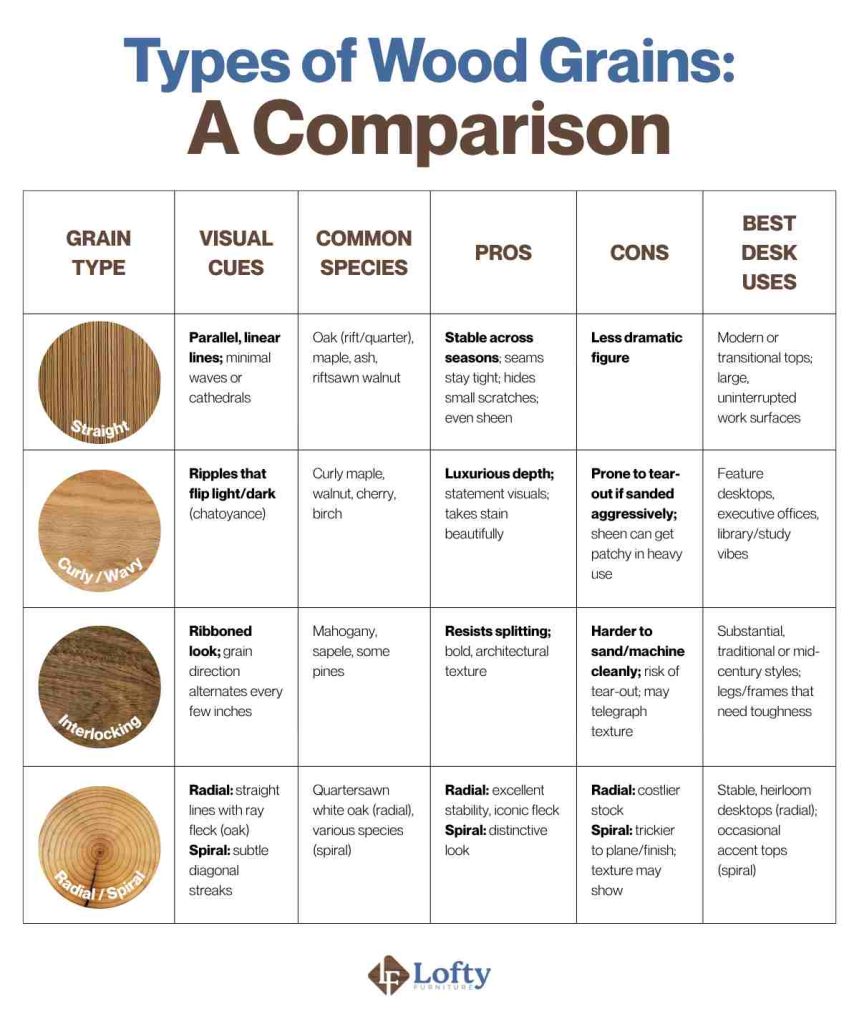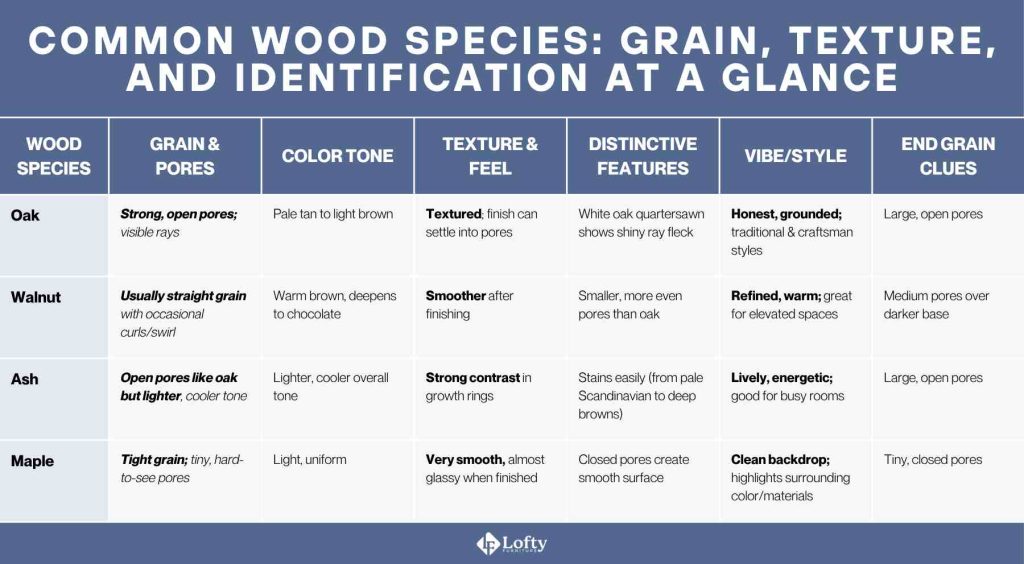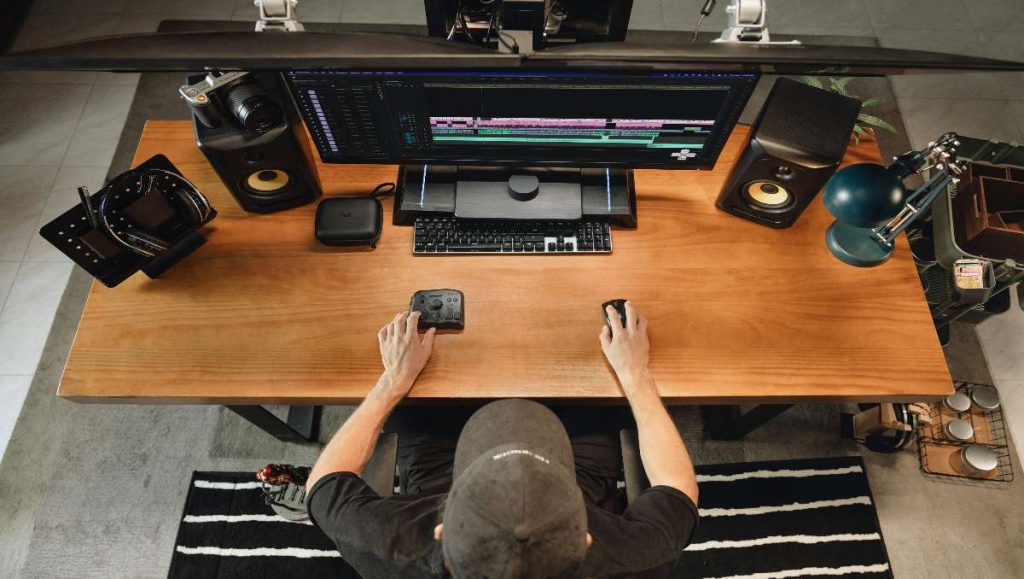If you’ve ever stood in a lumber yard or browsed through wood samples at a furniture store, you’ve likely noticed how no two pieces of wood look exactly the same. Some have swirling, almost marbled lines; others show clean, straight streaks running end to end. These natural variations—called wood grain patterns—aren’t just visual details. They can influence the feel, function, and personality of a desk more than you might expect.
Key Takeaways:
- Understanding different wood grain patterns helps you predict how a desk will perform over time, especially in terms of stability and wear.
- Choosing the right finish—water-based polyurethane, oil-based polyurethane, or hardwax oil—can protect your desk and enhance the wood’s natural beauty based on your usage needs.
- Proper care, including controlling humidity and using protective accessories, is essential to maintain your desk’s appearance and longevity.
In this article, we’ll break down the most common types of wood grains, explain what they mean for durability and aesthetics, and help you choose the perfect match for your workspace.
Understanding Wood Grain and Why It Matters

Wood grain is the natural pattern formed by a tree’s growth and how the log is cut, creating unique looks and textures in each board. Think of the trunk like a bundle of straws—cutting it at different angles reveals different grain patterns, which is why two desks made from the same raw wood can look and feel very different. Tight growth rings create a clean, refined appearance, while wider rings give a rustic, bold look; some cuts, like in oak, may even show shiny flecks.
Grain also affects performance: straight grain is more stable and finishes well, while bold or wavy patterns may shift with humidity. Quartersawn boards with straight grain tend to resist warping better than flatsawn boards with sweeping patterns. Even a high-quality veneer over a stable core can outperform cheaper solid wood. Understanding grain helps you choose a desk that looks great, feels right, and lasts longer.
Common Types of Wood Grains
Grain isn’t just about looks—it plays a big role in how your desk holds up over time. It’s like a blueprint that influences both the surface appearance and how the wood behaves with use, wear, and changes in humidity. Here’s a quick look at some of the most common grain patterns you’ll come across when choosing the best wood for desk.
Straight Grain
Straight grain shows up as clean, parallel lines that run the length of the board—think of train tracks. It comes from cuts that follow the natural direction of the wood fibers, especially in quartersawn or riftsawn lumber. This makes the surface feel calm and tidy, and it performs well too: it’s stable, resists warping, and finishes evenly. It’s a great choice for modern or minimalist desks where you want everything to look clean and stay that way.
Curly or Wavy Grain
Curly grain looks like soft waves or ripples that catch the light as you move around it, creating a shimmer known as chatoyance. You’ll often see it in curly maple, but also in walnut, birch, and cherry wood. It adds a rich, three-dimensional effect that stands out under a clear finish. It takes a bit more care when sanding and finishing, but if you like furniture with character and don’t mind a little extra upkeep, this grain is a stunner.
Interlocking Grain
Interlocking grain happens when the wood fibers twist in alternating directions, creating a layered or ribbon-like texture. Woods like mahogany and sapele often show this look. It’s strong and resistant to splitting, but it can be a little tricky to sand smooth. With regular dusting and a gentle cleaning routine, it’s a great option if you want a desk with bold texture and a bit of visual drama.
Radial and Spiral Grain
Radial grain comes from cutting straight out from the center of the log, and it’s known for clean, straight lines and beautiful ray flecks, especially in quartersawn oak. Spiral grain, on the other hand, twists gently around the trunk, creating diagonal streaks. Radial grain is more common for desks because it’s stable and easy to finish, while spiral grain is less used due to its tendency to move and its finishing challenges—but if done right, it can offer a unique, textured surface.
Here’s a quick side-by-side to help you compare grain types at a glance.:

How to Read Grain Patterns and Identify Wood Types
The grain pattern you choose doesn’t just shape how your desk looks; it affects how it wears, reacts to humidity, and holds up over time. Whether you’re drawn to straight lines, soft waves, or bold ribbons, learning to spot these grain types helps you make a confident, informed choice.
Visual Tests
Examine the surface under angled light. Straight, parallel lines usually mean stable quartersawn cuts, while wide cathedral patterns suggest flatsawn boards that may shift with humidity. Ripples or shimmering effects reveal curly or figured grain, adding texture.
Look for pores and rays too—oak and ash have large, open pores you can often see or feel, maple’s pores are tiny and smooth, and walnut falls in between with medium pores and rich color. Rays, especially shiny flecks in quartersawn white oak, are a good species clue. Checking the end grain (ask for close-up photos if buying online) gives extra clarity: large pores for oak/ash, tight pores for maple, and medium pores for walnut.
Tools and Tactile Tests
Use a magnifier or your phone’s macro lens for close-up details, and a pocket ruler to check board widths and seam spacing. Wipe with a white microfiber cloth to see if finishes are fully cured.
Tap the surface—solid wood or quality plywood sounds dense, while particleboard feels hollow. Run your hand over the wood: straight grain feels smooth, open-pored woods like oak feel lightly textured, and curly grain may feel subtly uneven. Touch helps you understand the finish and durability.

Finishes That Protect and Highlight Wood Grain
Choosing the right finish for your desk is about more than just looks—it protects the surface and shapes how the wood grain shines in your space. Most desks are finished with one of three main types: water-based polyurethane, oil-based polyurethane, or hardwax oil. Each offers a different look and feel, plus pros and cons for maintenance.
- Water-based polyurethane dries clear and keeps the wood’s natural tone, making it perfect for light woods or cool color schemes. It cures quickly, has low odor, and offers strong scratch and spill resistance.
- Oil-based polyurethane adds warmth and depth, especially to woods like walnut or cherry. It builds a thicker, more moisture-resistant film but takes longer to dry and has a stronger smell during application.
- Hardwax oil soaks into the wood for a soft, natural feel without a plastic-like film. It’s easy to spot-repair with fresh oil but offers less resistance to water and harsh cleaners, so coasters and gentle cleaning are a must.

Choosing the Right Grain Pattern for Your Desk
Your desk isn’t just about function. It has to look right today and wear well over time. Picking the right grain pattern ensures your desk fits your style and daily use.
Aesthetic Fit: Modern rooms often work best with calm, straight grain on lighter woods. Traditional spaces shine with quartersawn oak’s ray flecks, while bold curly maple or figured walnut adds wow-factor to statement pieces.
Room Size & Light: Busy grain can overwhelm a small space, but adds life to a large, sunny office. Position your desk so light grazes the grain and reveals its natural beauty.
Practical Needs: For heavy use—multiple monitors, lots of stuff—choose stable, straight-grain, durable woods finished with polyurethanes. For a tactile writing surface, a hardwax oil on smooth maple feels great.
Wood Movement: Quartersawn boards are more stable across seasons than flatsawn, reducing warping and seam issues in wide desktops. If you’re considering veneer, pick high-quality faces on stable cores for better durability.
How to Keep Your Desk Looking Great for Years

Your desk set up will last as long as your habits allow. Protect the grain with simple routines that prevent damage before it starts.
- Use coasters and a breathable desk pad to protect the surface.
- Lift items instead of sliding them to avoid scratches.
- Dust regularly with a dry or slightly damp microfiber cloth.
- Clean spills promptly with a damp cloth and mild soap, then dry immediately.
- Use cleaners and maintenance products that match your desk’s finish.
- Keep indoor humidity between 30% and 50% to prevent wood movement.
- Avoid placing your desk in direct sunlight or near heat sources.
- Add felt pads under accessories to prevent micro-scratches.
Conclusion
Choosing the right wood grain for your desk is about more than just appearance—it’s about finding the perfect balance of beauty, durability, and functionality that fits your space and lifestyle. Understanding how different grain patterns affect stability and wear helps you select a desk that not only looks great but also stands up to daily use. Pairing your chosen grain with the right finish ensures your desk’s character shines through while staying protected.
Before making a purchase, take the time to examine the wood closely, ask about construction details, and confirm the finish used. This knowledge empowers you to buy with confidence, knowing your desk will age gracefully and perform well over time.
Frequently Asked Questions
Is a glass top a good way to protect a wood desk’s grain?
A tempered glass top can effectively protect a wood desk from spills and ink while still showing off the grain. Adding small, clear bumpers helps air circulate and prevents moisture buildup, and using an ammonia-free cleaner keeps nearby wood from hazing.
Does sunlight change how wood grain looks over time on a desk?
Sunlight can alter the color and tone of wood grain, especially in species like cherry and walnut, while UV rays can also affect the finish’s sheen. Using window treatments and rotating desk accessories helps maintain even color, and choosing UV-resistant finishes protects the wood near bright windows.
Which direction is wood strongest?
Wood is strongest along the grain, meaning parallel to the fibers running lengthwise. This direction supports the most load and resists bending better than across or against the grain.
What is the weakest direction of wood?
Wood is weakest perpendicular to the grain, especially across the growth rings, where it is more prone to splitting and breaking. This direction offers less structural strength and stability compared to along the grain.
Is it possible to fake wood grain?
Yes, it’s possible to fake wood grain using techniques like wood-graining paints, veneers, or printed laminates that mimic natural patterns. However, these imitations often lack the texture and durability of real wood.
What colors work best for wood graining?
Natural wood tones like browns, tans, and warm amber hues work best to highlight grain patterns realistically. Using layered shades and subtle contrasts enhances the depth and texture of the wood grain effect.
